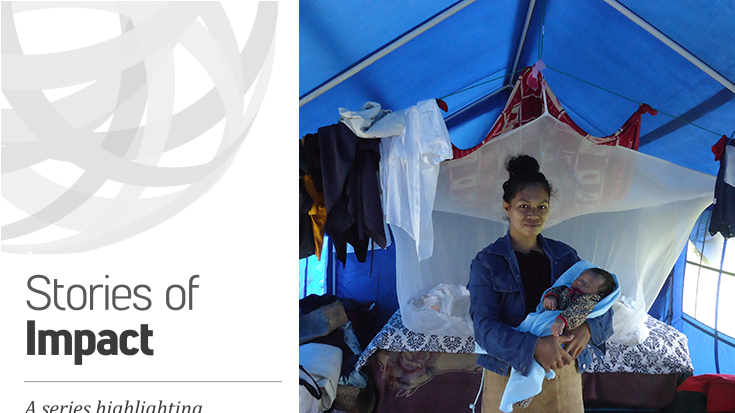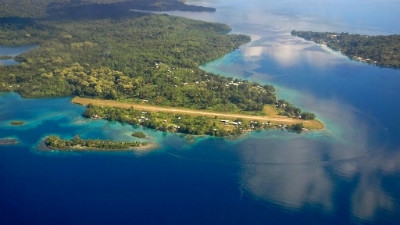REGION: EAST ASIA AND THE PACIFIC
COUNTRY: TONGA
FOCUS AREA: RESILIENT RECOVERY
Results & Achievements
- With the World Bank's support, Tonga developed a Housing Recovery and Reconstruction policy clearly outlining the government's strategy for housing reconstruction and self-recovery after Tropical Cyclone Ian.
- A damage assessment helped to leverage $12 million in World Bank grants and low-interest credits, and a $2 million grant from the ACP-EU NDRR Program.
- Cyclone-proof housing design was completed and reconstruction contracts awarded within six months after the disaster.
- The housing assessment and field surveys have helped to forge a coalition between the government, local communities, and civil society organizations including the Tongan Red Cross, and other stakeholders.
Tonga is one of the countries in the world most vulnerable to the effects of natural disasters and climate change. In January 2014, Tropical Cyclone Ian swept through the Pacific island nation, causing significant damage to housing and critical infrastructure.
The government, the World Bank, and the Global Facility for Disaster Reduction and Recovery (GFDRR), with funding from the Africa Caribbean Pacific-European Union Natural Disaster Risk Reduction Program (ACP-EU NDRR), worked to rapidly assess the damages, and implement a recovery program which would strengthen the housing and transport infrastructure sectors against future natural hazards.
The 176 island archipelago of Tonga is exposed to a range of natural hazards, with estimated annual average disaster losses from cyclones, earthquakes and tsunami equivalent to 4.4 percent of Gross Domestic Product (GDP). Recorded as the most powerful storm to ever hit the Pacific island nation, Tropical Cyclone Ian affected some 5,500 people—almost 70 percent of the Ha’apai island group inhabitants, and caused damages and losses of $50 million or 11 percent of Tonga’s GDP. The housing sector was particularly affected, with nearly a thousand houses and public buildings—or about 75 percent of Ha’apai’s housing stock –destroyed or severely damaged.
Approach
The government, the World Bank and GFDRR supported resilient recovery by conducting a rapid disaster assessment, followed by a detailed damage and socio-economic assessment of the affected households. Using remote sensing, geo-information and field surveys with global positioning systems (GPS) these damage assessments formed the basis for Ha'apai housing recovery and reconstruction policy. The assessments contributed to World Bank and ACP-EU reconstruction and recovery investments and technical assistance, which:
- Provides best practice on housing recovery and reconstruction, including 'building back better' principles and climate resilience, public grievance systems, and capacity building on safe home construction.
- Supports housing reconstruction, repairs and retrofitting for some 1,000 households through the Tonga Cyclone Reconstruction and Climate Resilient Project.
- Rehabilitates priority infrastructure including roads, airports, and ports in Ha'apai.
Lessons Learned
Investing in prevention saves lives and mitigates the scale of disaster impact. Field assessments revealed that properly designed and constructed housing infrastructure prevented more deaths, injuries, and physical damage. In many places, houses constructed to cyclone standards in the early 1980s were untouched by the disaster, while being surrounded by many newer homes, which were completely destroyed or severely damaged.
Innovative tools can support recovery planning and reconstruction. For the housing assessment, new technology was used, including using a hand-held device with integrated GPS. This allowed faster and more efficient collection of data, which can be used for reconstruction and future development.
Integration of 'building back better' principles into recovery is important for building long-term resilience.Long-term resilience is strengthened through interventions such as retrofitting homes and water supply systems, updating building codes, setting up compliance systems, raising public awareness, hazard mapping, and improving national disaster recovery and reconstruction frameworks.
Next Steps
Housing assistance and infrastructure reconstruction are under implementation. The long-term strategy is to increase the resilience of Tonga’s vulnerable population and sectors through continued engagement with the government, in line with the government’s National Infrastructure Investment Plan and Joint National Action Plan on Disaster Risk Management and Climate Change. This will also be done through Tonga’s participation in a planned regional Pacific Resilience Program (PREP) to strengthen disaster resilience, early warning and preparedness, and improve post-disaster response capacity of participating Pacific Island countries.

